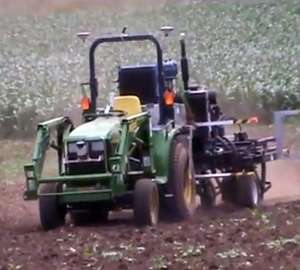Robotic tractor to deliver precision planting

A robotic tractor and seeding machine with unprecedented planting accuracy will improve agricultural productivity for farmers and enable cropping on 20% more land, UNSW inventors say.
Broad acre farming currently requires an operator to be present in the cabin of large tractors, but this is often perceived as being unproductive, says Associate Professor Jay Katupitiya from the School of Mechanical and Manufacturing Engineering at UNSW.
Furthermore, large tractors are expensive and compact the soil as they move, creating crop lines. Crop lines render roughly 20% of land on large paddocks unusable and means cropping must happen in the same direction every year, which degrades soil health.
To solve this problem, Katupitiya has partnered with the Grains Research and Development Corporation (GRDC) to develop a lighter, more affordable agricultural machine that can accurately follow and plant seeds along a predefined path without a human operator.
"This system has the ability to lay seeds within one to two centimetres of lateral accuracy on rough agricultural terrain, which is an unprecedented level of precision for an autonomous machine," says Katupitiya.
Achieving this precision with existing technology has been challenging because the forces generated by a plough digging into soil often cause seeding implements to veer off course. However, advanced control systems and sensors, and an optimised design, enable the UNSW invention to automatically correct against these deviations.
"Our unique design and technology allows farmers to know exactly where their crop is," says Katupitiya. "It means the same machine can be used repeatedly throughout the cropping season to carry out all other subsequent tasks, such as weeding, fertilising and growth monitoring."
The UNSW-developed machine, which measures just three-metres wide, is a more affordable and lightweight option for farmers, says Katupitiya, which doesn't create crop lines.
"The flexibility of being able to access more land and plant crops in different directions has advantages for crop growth through better uptake of remnant nutrients, and a better yield," says Katupitiya.
The research team behind the invention were finalists in the 2012 Eureka Prize for Innovative Use of Technology. They are now working with the GRDC to pursue further development and commercial production.
Provided by University of New South Wales



















